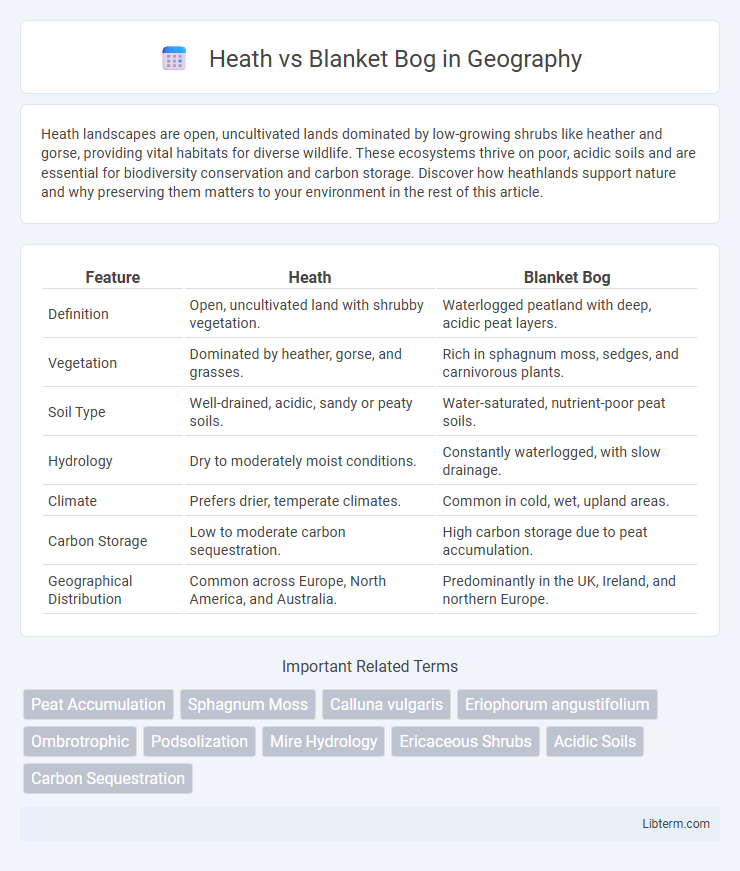Heath landscapes are open, uncultivated lands dominated by low-growing shrubs like heather and gorse, providing vital habitats for diverse wildlife. These ecosystems thrive on poor, acidic soils and are essential for biodiversity conservation and carbon storage. Discover how heathlands support nature and why preserving them matters to your environment in the rest of this article.
Table of Comparison
| Feature | Heath | Blanket Bog |
|---|---|---|
| Definition | Open, uncultivated land with shrubby vegetation. | Waterlogged peatland with deep, acidic peat layers. |
| Vegetation | Dominated by heather, gorse, and grasses. | Rich in sphagnum moss, sedges, and carnivorous plants. |
| Soil Type | Well-drained, acidic, sandy or peaty soils. | Water-saturated, nutrient-poor peat soils. |
| Hydrology | Dry to moderately moist conditions. | Constantly waterlogged, with slow drainage. |
| Climate | Prefers drier, temperate climates. | Common in cold, wet, upland areas. |
| Carbon Storage | Low to moderate carbon sequestration. | High carbon storage due to peat accumulation. |
| Geographical Distribution | Common across Europe, North America, and Australia. | Predominantly in the UK, Ireland, and northern Europe. |
Overview: Heath and Blanket Bog Ecosystems
Heath ecosystems are characterized by open, shrubby landscapes dominated by heather, gorse, and grasses thriving on well-drained, acidic soils. Blanket bogs form extensive peatlands with waterlogged, nutrient-poor conditions, supporting sphagnum mosses and specialized flora adapted to cold, wet climates. Both ecosystems play crucial roles in carbon storage, biodiversity conservation, and water regulation across temperate regions.
Key Characteristics of Heath
Heath is characterized by open, low-growing woody vegetation dominated by species such as heather (Calluna vulgaris) and gorse (Ulex spp.), thriving in acidic, nutrient-poor soils. It supports a diverse range of flora and fauna adapted to well-drained, dry conditions and often features sandy or gravelly substrates. Unlike blanket bogs, heathland soil remains relatively dry, preventing the extensive peat buildup typical of bog environments.
Key Features of Blanket Bog
Blanket bog is a type of peatland characterized by its extensive, thick layers of peat formed from partially decomposed sphagnum moss under waterlogged conditions, primarily in cool, humid climates. It covers large expanses of the landscape, creating a continuous, "blanket-like" layer over slopes and flat surfaces, distinguishing it from the more patchy distribution of heath. Key features include high carbon storage capacity, acidic, nutrient-poor soils, and a unique assemblage of specialized plant species such as cotton grass, heather, and sphagnum moss that thrive in saturated environments.
Geographic Distribution of Heath and Blanket Bog
Heath primarily occurs in temperate regions across Europe, North America, and parts of Australia, flourishing on well-drained, acidic, and nutrient-poor soils. Blanket bogs are predominantly found in cool, wet climates such as the British Isles, northern Europe, and parts of Canada, where persistent moisture leads to thick peat accumulation over large areas. The key geographic distinction lies in heath's tolerance for drier upland slopes, whereas blanket bogs dominate flat or gently sloping terrain with consistently high rainfall.
Soil Composition and Hydrology Differences
Heath soils are typically well-drained, acidic, and nutrient-poor with a higher proportion of sandy and gravelly particles, promoting aerobic microbial activity. Blanket bogs feature waterlogged, peat-rich soils with high organic matter content and low decomposition rates due to saturated, anaerobic conditions that retain significant moisture. Hydrologically, heath landscapes exhibit rapid surface runoff and deeper soil infiltration, whereas blanket bogs function as natural sponges with slow water movement and persistent water saturation influencing carbon storage.
Dominant Flora and Fauna in Heath
Heath ecosystems are dominated by dwarf shrubs such as Calluna vulgaris (heather), Erica cinerea (bell heather), and Ulex europaeus (gorse), which provide critical habitat for a variety of fauna. Key animal species found in heathlands include the European nightjar (Caprimulgus europaeus), Dartford warbler (Sylvia undata), and the silver-studded blue butterfly (Plebejus argus), all of which depend on the structural complexity and floral diversity of heath vegetation. The open, nutrient-poor soils of heath support a specialized community adapted to acidic environments, contrasting with the waterlogged, peat-accumulating plants typical of blanket bogs.
Unique Biodiversity of Blanket Bogs
Blanket bogs harbor a unique biodiversity characterized by specialized plant species such as Sphagnum mosses, cotton grasses, and heather, which thrive in their acidic, waterlogged conditions. These ecosystems support rare invertebrates and bird species like the golden plover and hen harrier, adapted to the peatland environment. The distinct hydrology and nutrient-poor substrates of blanket bogs create habitats unlike those in heaths, fostering unparalleled ecological niches.
Environmental Functions and Carbon Storage
Heath and blanket bog ecosystems play crucial roles in carbon storage, with blanket bogs acting as significant carbon sinks due to their thick, waterlogged peat layers that sequester large amounts of organic carbon over millennia. Heathlands contribute to biodiversity and provide habitat heterogeneity but store less carbon compared to blanket bogs because their soils are less waterlogged and have faster decomposition rates. Both habitats support water regulation and soil conservation, yet the carbon-rich peat of blanket bogs offers superior long-term climate mitigation through carbon sequestration.
Human Impacts and Conservation Challenges
Heath and blanket bog ecosystems face significant human impacts including drainage for agriculture, peat extraction, and afforestation, which degrade their unique biodiversity and carbon storage capacity. Overgrazing and burning practices alter vegetation structure, reducing habitat quality and resilience against climate change. Conservation challenges involve restoring hydrology, regulating land use, and implementing policies to protect these sensitive habitats from further degradation and promote sustainable management.
Restoration and Management Strategies
Restoration and management strategies for heath and blanket bog ecosystems prioritize re-establishing native vegetation and improving hydrological conditions to reverse degradation and enhance carbon sequestration. Techniques include controlled grazing, re-vegetation with heather or sphagnum moss, and blocking drainage systems to restore natural water retention. Ongoing monitoring and adaptive management optimize biodiversity conservation and ecosystem service delivery while mitigating peatland erosion and carbon loss.
Heath Infographic

 libterm.com
libterm.com